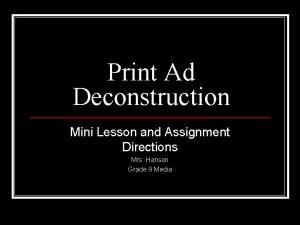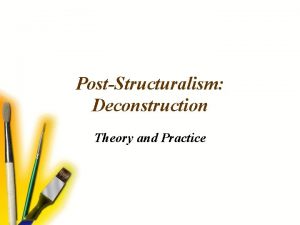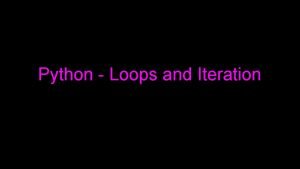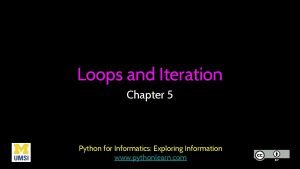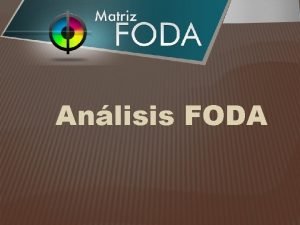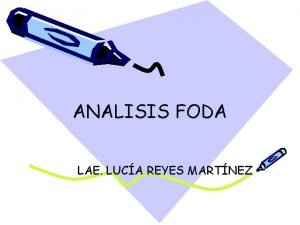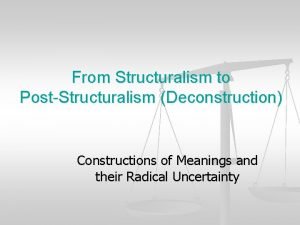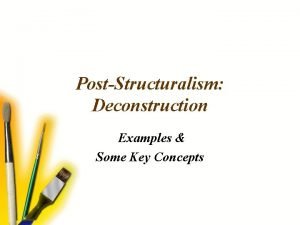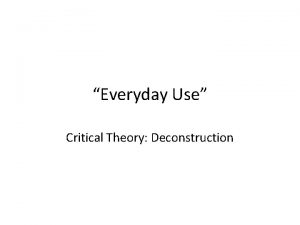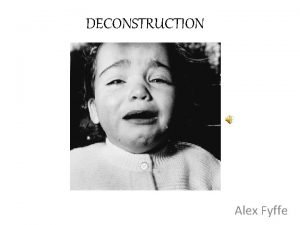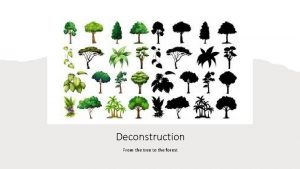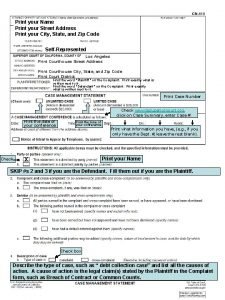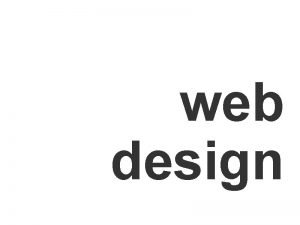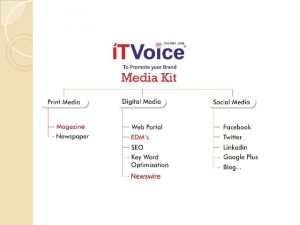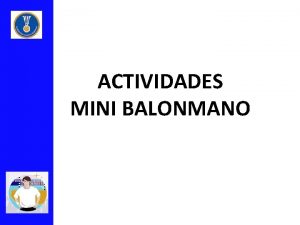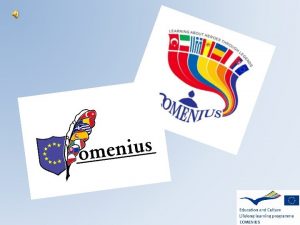Print Ad Deconstruction Mini Lesson and Assignment Directions










- Slides: 10

Print Ad Deconstruction Mini Lesson and Assignment Directions Mrs. Hanson Grade 9 Media

What is DECONSTRUCTION? n Deconstruction is a method used to analyze media. n Deconstruction is when we take a media example apart to look at the pieces used to create it and the effect they have on the final product. n Deconstruction leads to identifying and understanding messages conveyed beyond the selling of the product or service.

What do you have to do? 1. Get the needed materials: a print ad that you find interesting, poster board, glue, scissors, markers etc. 2. Study the ad. Use the questions on the assignment handout to guide your study and create rough copy notes. 3. Revise and edit your notes--add details and support for your ideas from the ad. 4. Prepare good copy and assemble poster. 5. Prepare to present your findings.

CONTEXT a) Who created this message? b) Who is the target audience? c) Why was this message sent? d) In what magazine is the ad found? PRINT AD DECONSTRUCTION SUBTEXT The ad suggests a meaning—it doesn’t state the meaning directly. --What are some possible messages that the advertiser wants you to think or feel after viewing this ad? --Explain your answer to this question with direct reference to the advertisement. CREATIVE TECHNIQUES Colour and Design --How is colour used to attract my attention? --Evaluate the layout of words and images. Is your eye drawn to one area? Is the layout simple or busy? Is the layout effective? Explain. --What kinds of technologies were used to construct this message? Language --Read all of the words on the page. What comes to mind when you see these words/phrases? What feelings do you experience when you look at the image(s)? ACCURACY --What is true and false about the subtext message in this ad? Appeals --What appeals/strategies are used? Explain. --How might different people understand this ad differently? Maslow --According to Maslow’s theory, to what human need is the advertiser connecting their product? --Explain

CONTEXT a) Cadbury Adams, which owns Trident, paid for this ad. b) This ad was found in a woman’s magazine, which means that women—most likely between 20 -50—are being targeted. Based on the style of dress and the nanny in the background, we can surmise that a high-end market is the primary socio-economic group targeted. c)This is a new product-line extension, which is being promoted to generate sales. d)This print ad was taken from Allure—a woman’s entertainment and beauty magazine.

CREATIVE TECHNIQUES Colour and Design The colour yellow is cleverly used in this advertisement. Notice that there are three main splashes of yellow—the frozen treat, the lady’s dress and the trident package. These three splashes of yellow contrast with the green background and draw the eye towards them. The size and placement of this colour forces the reader to follow a carefully crafted story: first the reader looks at the “problem” (the large frozen treat), then the eye will notice the “victim” (the lady) and finally the eye moves down to find the “solution” (the gum). By using a single colour that is bright and stands out, the creators of the ad focus our eye on the story and as a result, on the product!

CREATIVE TECHNIQUES Language The words and phrases that stand out to me in this advertisement are “Survive” and “Fight Back”. It seems that feeling hungry is a negative thing. These words give me the impression that feeling hungry is a feeling that should be resisted and overcome. Appeals Two main appeals are employed in this advertisement. First, “The-Slice-of-Life” strategy. Clearly a story is being told that includes a conflict (being hungry) and the product is offered as a solution. Second, the “humour strategy” is used. Some people might find it funny that this beautiful woman is battling with a giant frozen villain.

Maslow According to Maslow’s theory, the advertiser is connecting Trident to esteem needs. The ad suggests that you will achieve success, confidence and power if you resist the temptation to eat and chew this gum instead.

SUBTEXT The unstated message of this ad is that women’s bodies must be controlled. If we want to be beautiful, we must fight against our body’s natural desires. The woman in this image is thin, feminine (dainty shoes/sundress) and strong (she is holding a trike over head). If we want to be like this, we must fight the urge to eat.

CONTEXT PRINT AD DECONSTRUCTION a) Cadbury Adams, which owns Trident, paid for this ad. b) This ad was found in a woman’s magazine, which means that women—most likely between 20 -50—are being targeted. Based on the style of dress and the nanny in the background, we can surmise that a highend market is the primary socio-economic group targeted. c)This is a new product-line extension, which is being promoted to generate sales. d)This print ad was taken from Allure—a woman’s entertainment and beauty magazine. CREATIVE TECHNIQUES Colour and Design The colour yellow is cleverly used in this advertisement. Notice that there are three main splashes of yellow—the frozen treat, the lady’s dress and the trident package. These three splashes of yellow contrast with the green background and draw the eye towards them. The size and placement of this colour forces the reader to follow a carefully crafted story: first the reader looks at the “problem” (the large frozen treat), then the eye will notice the “victim” (the lady) and finally the eye moves down to find the “solution” (the gum). By using a single colour that is bright and stands out, the creators of the ad focus our eye on the story and as a result, on the product! SUBTEXT Language The unstated message of this ad is that women’s bodies must be controlled. If we want to be beautiful, we must fight against our body’s natural desires. The words and phrases that stand out to me in this advertisement are “Survive” and “Fight Back”. It seems that feeling hungry is a negative thing. These words give me the impression that feeling hungry is a feeling that should be resisted and overcome. The woman in this image is thin, feminine (dainty shoes/sundress) and strong (she is holding a trike over head). If we want to be like this, we must fight the urge to eat. Appeals ACCURACY To many women, this ad reinforces the incorrect idea that being thin is beautiful. With eating disorders on the rise and few girls and women celebrating their bodies regardless of their size, this ad perpetuates the unhealthy message that rather than have a healthy snack or eat a meal —you should eat gum. Clearly this problematic. Maslow According to Maslow’s theory, the advertiser is connecting Trident to esteem needs. The ad suggests that you will achieve success, confidence and power if you resist the temptation to eat and chew this gum instead. Two main appeals are employed in this advertisement. First, “The-Slice-of-Life” strategy. Clearly a story is being told that includes a conflict (being hungry) and the product is offered as a solution. Second, the “humour strategy” is used. Some people might find it funny that this beautiful woman is battling with a giant frozen villain.
